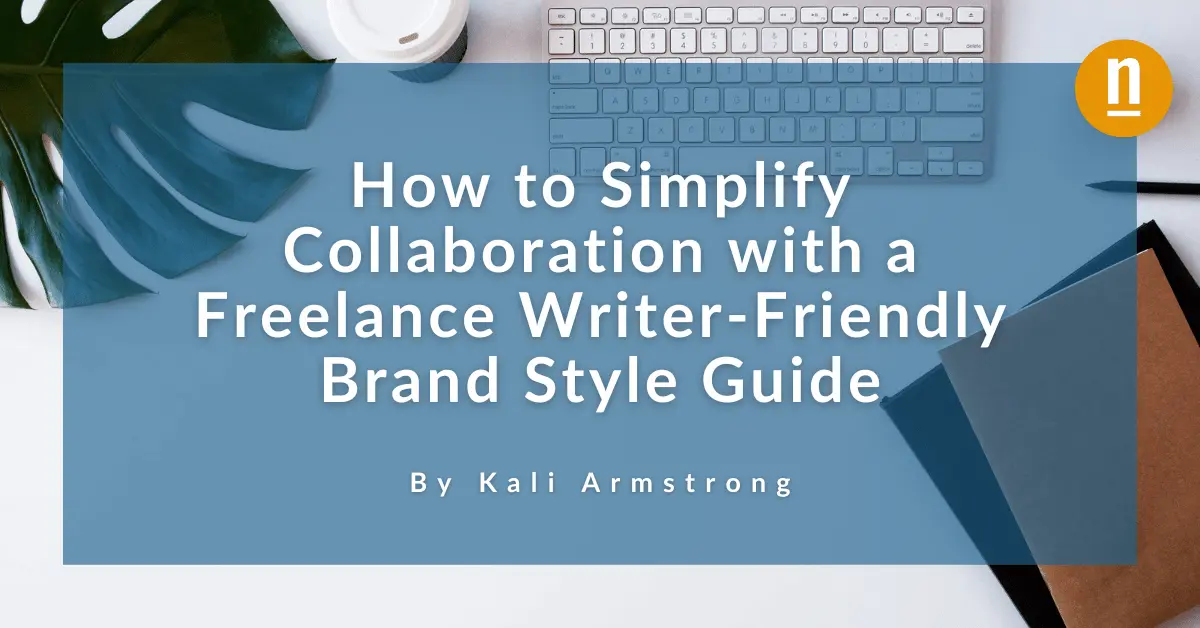Imagine being at a silent disco, dancing among strangers, only to discover your headphones are playing a completely different tune. You’d probably feel a bit offbeat and awkward, and that’s exactly how it feels to write for a brand without a freelance writer-friendly style guide.
Thankfully, with a few tweaks, your brand style guide can act as the metronome — keeping your brand and freelancers in sync so you can both dance the night away without missing a beat.

Benefits of Using a Freelance Writer-Friendly Brand Style Guide
Just like crafting a carefully choreographed dance, creating a comprehensive brand style guide takes time and effort. But, without it, you run the risk of orchestrating an intricate ballet only to see your freelancers freestyling on the sidelines.
And while the clash of conflicting styles might be amusing to watch, it’s no way to manage your brand’s identity. That’s because when it comes to your brand’s voice, consistency begets trust, and trust is the cornerstone of customer loyalty.
This trust isn’t just a warm and fuzzy feeling, either. It’s a dynamic force that fuels revenue growth. Brands, both big and small, have experienced remarkable increases ranging from 10% to well over 20%, all thanks to the power of brand consistency.
Clearly, consistency matters, but that doesn’t mean your internal team has to take on the bulk of your content. With a freelance-friendly brand style guide, you can remove the uncertainty from collaboration, publish consistent content, and reduce the need for excessive revisions (which cost creative teams an average of 5-10 hours per week). And since freelancers love a style guide, you’ll be able to attract experienced writers capable of achieving measurable results — making it an organizational win on all accounts.

Identify Brand Elements in Your Freelance Writer Style Guide
While the benefits of a freelance writer-friendly style guide are vast, they are directly tied to the quality of your guide. So, it’s crucial to invest time in defining the foundational brand elements that will underpin your guide.
Brand Voice and Tone
Naturally, your brand voice and tone are integral components of your brand style guide. As such, it’s essential to clearly define the voice and tone that best represents your brand. Start by considering how you want your audience to relate to your brand. Are you a casual and approachable friend or a more formal and authoritative colleague? Defining these aspects clearly will help freelance writers nail their tone, minimize revisions, and streamline the content creation process.
Target Audience
Although you may have strong opinions regarding how you want your brand voice to sound, understanding who your content speaks to is essential to ensuring your messaging comes across effectively.
To understand the importance of your target audience, consider how different your messaging would be for Gen Z college students versus retiring Baby Boomers. The language, the lingo, and even the medium would likely be different, which is why defining your target audience is essential before moving forward.
Core Values and Mission
Since your brand voice and style guide is, unsurprisingly, an extension of your brand, your mission and core values should be included as well. Freelance writers, in particular, need to be aware of what your brand stands for and what you aim to achieve in order to infuse their writing with the same principles. This will also help ensure they don’t inadvertently include examples or metaphors that clash with your core values.

Structuring Your Freelance Writer Style Guide
With these key brand elements in place, you can start building out your style guide. Although the structure of your guide is ultimately up to you, incorporating the following sections will help create a cohesive brand identity across all communication channels.
Overview and Introduction
This section should provide a birds-eye view of your brand, including the core values and mission we discussed above. It’s also important to include the overarching purpose of the style guide and explain how maintaining a consistent brand identity will serve that goal.
Visual Aesthetics and Formatting
To further support brand consistency, your brand style guide should also include visual components. This can include anything from preferred layout, typography, color schemes, and any graphical elements that make up your brand’s visual identity.
Keep in mind that regardless of whether we’re talking about copy or graphics, consistency is key. So, be sure to carefully curate your design choices in line with your brand’s personality and values.
Writing Style and Mechanics
This section should specify your brand’s grammatical, syntactical, and stylistic preferences. These content guidelines can include punctuation preferences (like the highly debated Oxford comma), capitalization, word usage, and even the way your sentences are structured. If you’re having trouble conceptualizing how you want your brand to sound, try to imagine it as a person.
- How would they talk in a conversation?
- Are they super descriptive or cryptic?
- Do they overexplain or get straight to the point?
Researching the way your target audience speaks should help guide your writing style. After all, if you want to connect with someone, it helps to speak the same language.
Accessibility
Even if your brand doesn’t currently hire freelancers, you’ll inevitably hire new employees and may enlist outside help in the future, so your style guide should be user-friendly. Consider ease of navigation and clarity, explain frequently used acronyms, and include alternative mediums to accommodate those with disabilities.
Tone and Voice Specifications
While each aspect of your style guide is important, defining your brand’s tone and voice is arguably the most significant (particularly when hiring freelance writers). It’s important to recognize that while your brand may possess a distinct and robust voice on your website and social channels, using the same tone for every interaction may not always be ideal.
Let’s take Wendy’s as an example. They’ve built a reputation as a sassy and witty brand on Twitter by roasting their competitors and commenting on seemingly unrelated (yet trending) content. So, if you sent an email of complaint to their corporate address, you likely wouldn’t be met with the same sass. And while this may seem obvious to some, it’s always best to overexplain than assume.
Include hypothetical audience interactions with appropriate scripts to demonstrate how your brand speaks in different situations.
Terminology and Jargon
Whether you’re in the hospitality industry or construction, your brand likely uses industry-specific terminology and jargon that may not be common knowledge, especially for freelancers. List any industry-specific terms, their definitions, and how to use them correctly to ensure your brand’s communication resonates with other professionals in your field.
Examples and Use Cases
As thorough as the rest of your brand guide may be, practical examples are one of the most valuable and efficient ways to help users understand and apply your brand elements. Include real-world examples of correct and incorrect uses of your brand elements to show writers exactly how to implement the guidelines effectively.
Incorporating these sections will ensure your brand style guide is a comprehensive resource that empowers users (internal or otherwise) to create content that represents your brand’s identity and resonates with your audience.

Tips for Using a Freelance Writer-Friendly Brand Style Guide to Simplify Collaboration
As the demand for content continues to grow, tapping into the expertise of freelance writers has become essential for many. Yet, without a freelancer-friendly style guide, you could find yourself spending as much time revising off-brand content as you would have spent writing it yourself — which isn’t exactly efficient.
The silver lining?
Freelance writers are known for adhering to rules, and brand style guides are the ultimate rulebook. Here are some tips to ensure your brand guide is freelance writer-friendly.
Provide Clear and Concise Guidance
Unlike your internal teams, freelancers won’t automatically know the ins and outs of your business and might need a bit more explanation (at least at the onset of your relationship). For this reason, it’s important to make your brand style guide as straightforward as possible. Clear guidelines eliminate ambiguity, allowing freelancers to produce content that aligns with your brand identity on the first try.
Balance Consistency and Flexibility
While consistency is vital, it’s equally important to grant writers some flexibility to adapt to various content formats and platforms. Most writers would agree that nothing stifles creativity quite like an overly rigid approach. Finding the right balance between consistency and creative expression can be a tightrope to walk, but the results are well worth it in the end.
Embrace Collaboration and Feedback
Like any collaborative relationship, open communication is critical to long-term success. Freelance writers are experts in brand voice and can offer fresh perspectives that could significantly enhance your guide and branding. To maximize the benefits of your collaboration, actively encourage feedback and remain receptive to adjusting your guide.
Keep Your Freelance Writer Style Guide Current
Keep in mind that your style guide shouldn’t be a static document. It should evolve along with trends, industry standards, and the evolution of your brand. Come back to it regularly and ensure your freelancers are made aware of any changes.

Empowering Every Freelance Writer with Your Brand Style Guide
Ultimately, your brand style guide should serve as the bridge that connects your brand’s voice with the storytelling capabilities of freelance writers and ensures your messaging remains clear and impactful. But don’t forget that freelance writers bring unique expertise to the table.
By actively involving them in the refinement of your style guide, you’ll cultivate a dynamic relationship that enables your guide to evolve with your brand’s vision, resulting in content that resonates, engages, and delivers results.
With that in mind, we invite our valued freelance writers to share their insights with us. How could we improve this guide to foster collaboration between brands and freelancers? Let us know on LinkedIn!
About the Author:
 Kali Armstrong is a passionate freelance writer dedicated to helping others share their unique stories. With expertise in content writing and copywriting, she skillfully crafts engaging materials for businesses seeking to refine their brand voice and expand their reach. Kali’s commitment to creating value-driven content strategically designed to attract premium clientele has made her a go-to resource for many clients across diverse industries. Check out her writer profile here: Kali Armstrong.
Kali Armstrong is a passionate freelance writer dedicated to helping others share their unique stories. With expertise in content writing and copywriting, she skillfully crafts engaging materials for businesses seeking to refine their brand voice and expand their reach. Kali’s commitment to creating value-driven content strategically designed to attract premium clientele has made her a go-to resource for many clients across diverse industries. Check out her writer profile here: Kali Armstrong.
